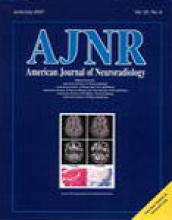Until recently, options for cerebral blood flow measurements were restricted to positron emission tomography (PET) or xenon CT (Xe-CT) that applied freely diffusible tracers for perfusion assessment and tracer kinetic modeling. Because both techniques suffer from a somewhat limited availability, the introduction of perfusion CT for quantitative flow assessment has been received with immediate, strong enthusiasm from the neuroradiologic community. CT perfusion can be performed noninvasively on a standard CT scanner in a very short time and, potentially, in an emergency setting. Resulting quantitative information on cerebral blood flow could have tremendous implications for the management not only of acute stroke patients, but also of patients with chronic steno-occlusive vascular disease.
It is of utmost importance to validate the CT perfusion technique before using the resulting flow estimates for treatment decisions. Importantly, both the methodologies of data acquisition and kinetic analyses differ from established alternatives like PET or Xe-CT. Dynamic contrast-enhanced CT perfusion reflects a different physiology by using an intravascular tracer to assess perfusion rather than a freely diffusible tracer. Validation studies in animals already have been published (1).
Wintermark et al (2) present an important validation study of CT perfusion in humans. The authors address one important validation parameter, the accuracy of CT perfusion, comparing this technique with Xe-CT. Their major conclusion is that perfusion CT in regions excluding major vessels reveals flow values that are in agreement with the reference standard, Xe-CT. This is indeed a very important statement. However, a full, rigorous validation of perfusion CT requires more studies.
A careful consideration in validation studies is the definition of the study population. Wintermark et al present an inhomogeneous selection of underlying diseases. This leaves some questions unanswered: How does the technique perform in complicated physiological scenarios not found in this group of patients, eg, in a unilateral carotid occlusion with various amounts of collateral flow? Following this, what is the best way to use the CT perfusion technique? Flow quantification requires a vascular input function: which vessel (ipsi- or contralateral, more proximal or distal) should be used to calculate flow values in a hemisphere? And does the size of the vascular region of interest (ROI) matter? This is important not only for asymmetrical, but also for symmetrical flow. Are the flow maps affected by the vascular input (eg, anterior cerebral vs middle cerebral vs carotid artery), and if yes, which one is “more correct”? How much does the clinical history of a patient matter in the selection of a vascular ROI? These questions need to be addressed in a rigorously planned trial with defined inclusion and exclusion criteria.
Although these considerations still address the accuracy of CT perfusion, a second parameter for study validation has not been targeted: the reproducibility. CT perfusion analysis software is commercially available and will soon be widely distributed. The software providers emphasize that the technique is very easy to use. But does an untrained technologist really differ from an experienced researcher? Conversely, and importantly, how does an untrained researcher do compared with an experienced technologist? How much operator training is required to yield reliable flow values? How much can the process be automated? How does the same technologist (or radiologist) perform on different days? Clinicians have to be assured that the numbers are reliable regardless of the time and operator, before they can use them for treatment decisions.
To address these additional considerations is straightforward and in part underway in ongoing studies. Even when all the remaining questions are answered and the optimal use of the CT perfusion technique is defined, a last and yet unresolved technical limitation of the CT perfusion technique is, as indicated by the authors, its limited anatomic coverage. Even with multislice CT scanner technology such as that used by the authors, the anatomic coverage is limited to approximately 2 cm. In particular, in an acute stroke patient with a normal non-contrast CT scan, the ischemic area might be underestimated or even missed. This limitation has to be overcome with different imaging approaches (3) and/or CT scanner technology advances.
In summary, Wintermark et al take an important step toward the validation of a new, non-invasive technique for cerebral flow measurements. They demonstrate its potential value and accuracy compared with Xe-CT under optimal conditions with experienced readers. They also highlight pitfalls, such as the error introduced by inadvertent inclusion of vascular structures in analysis ROI. Thus, more work needs to be done regarding standardization and evaluation of sources or error, and more questions need to be answered, both of technical and practical value, before the CT perfusion technique can be unequivocally recommended to the radiology community for reliable flow quantifications.
References
- Copyright © American Society of Neuroradiology












